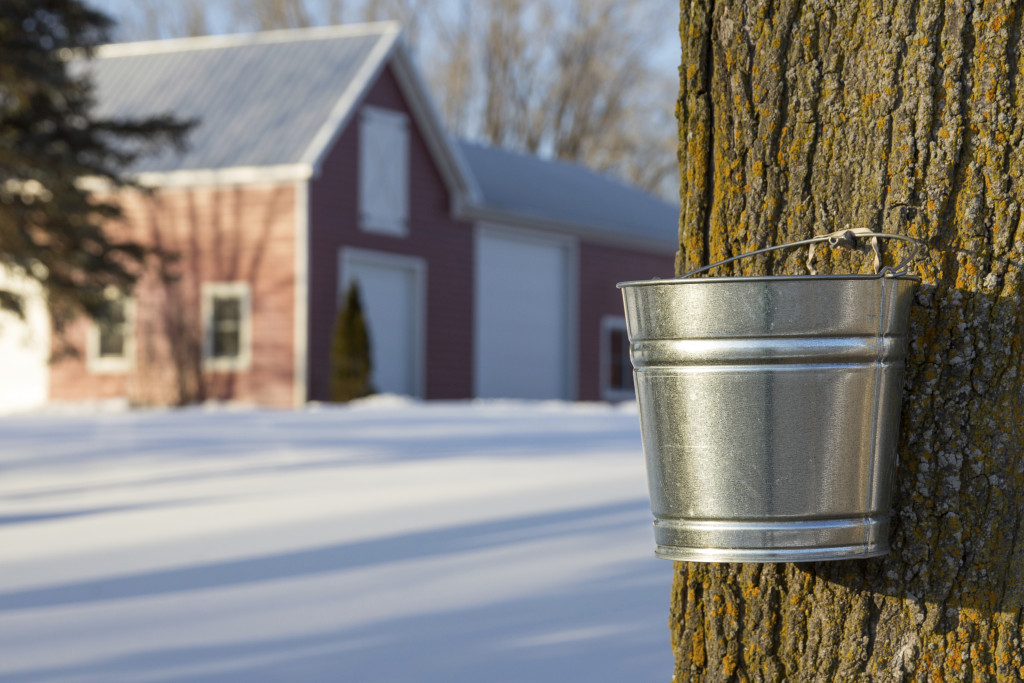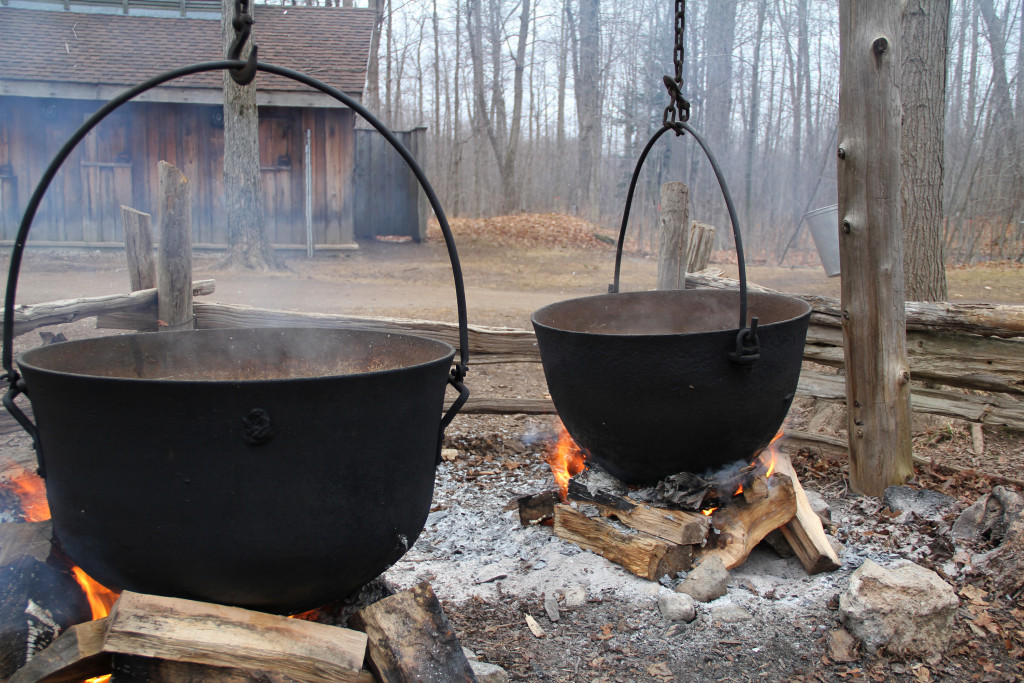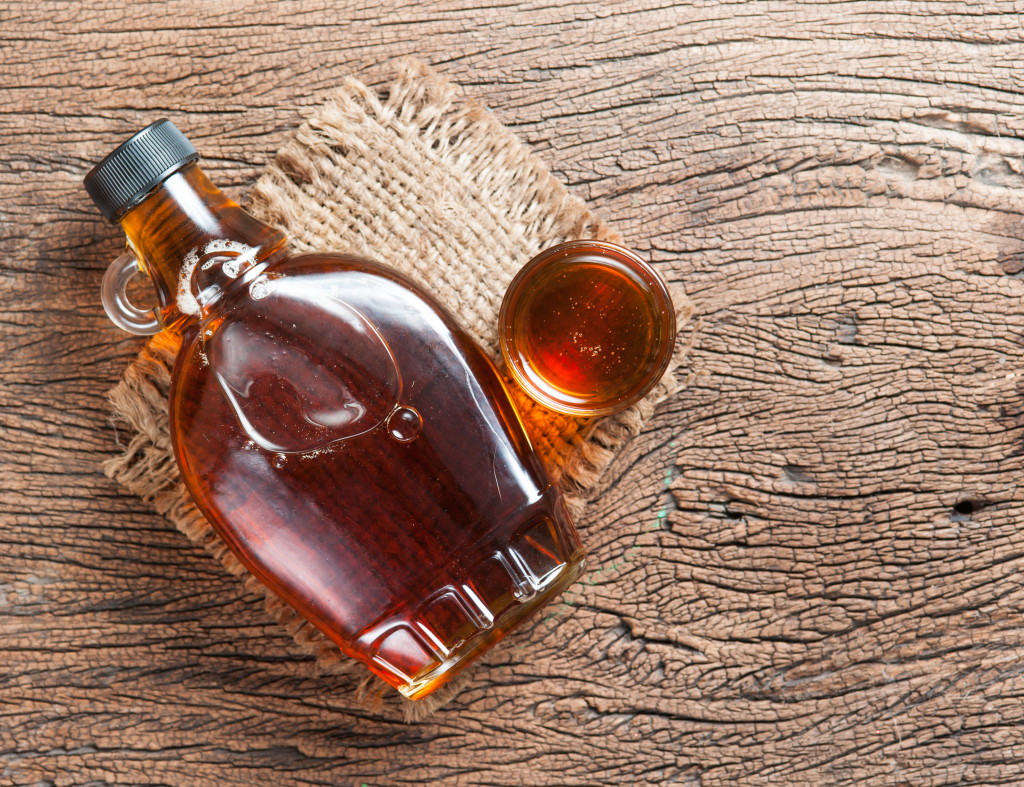Some foods just have an affinity for one another. Take pancakes or waffles, for example. They are so inextricably bound to maple syrup that you have to think twice about what else you might put on them—besides butter, of course.

History
There is no documentation of when tapping maple trees for their sap began and much of its legend is wrapped in Native American mythology.
One story goes that in late winter a Native American chief returning from a hunt threw his tomahawk at a maple tree, lodging it in the trunk. After some time, the sap dribbled down the handle of the tomahawk and into a cup made of birch bark. The chief’s wife, mistaking the clear, thin liquid for water, used it to cook some venison. Soon the liquid was reduced to a sticky, sweet, thick consistency and maple syrup was born.
When the Europeans arrived in the New World, Native Americans in the Northeast had already been tapping maple trees for their sap and boiling it to make maple syrup and crystallized sugar. In fact, Native Americans had rituals to celebrate the maple sap harvest as a rite of spring.
In lieu of metal vessels to boil the sap, natives used buckets made of birch bark or hollowed-out tree trunks filled with sap, into which they placed heated stones to raise the sap’s temperature to the boiling point.
By the mid-1700s Native Americans and colonists alike were using large copper and iron kettles to reduce thin and watery maple sap by boiling to syrup consistency.
Maple sugar was frequently used in place of cane sugar that had to be imported from the West Indies and was associated with the slave trade, which did not sit well with Quakers and abolitionists.
Production
Canada—the province of Quebec, specifically—produces 75–80% of the world’s maple syrup supply. The state of Vermont is the largest producer of all 50United States, accounting for about 5.5% of the world’s supply.
Maple tree sap comes from the naturally occurring starch within the tree that converts to sugar in late winter/early spring and turns into the clear, runny sap.
Native Americans put gashes in the tree trunk in order to get the sap to run. When Europeans arrived, they refined the process by using augers to drill holes in the tree instead, into which a wooden (and later metal) tap was inserted. A wooden bucket was then hung from the tap to catch the flowing sap.
Each tree in a stand of maple trees, called a sugar bush, can take up to three taps, depending on its trunk diameter. Trees can produce sap from the age of 30 to 40 years and up to 100 years. Each tree can produce up to 13 gallons of sap, and it takes about 39 gallons of maple sap to make one gallon of maple syrup.

Although, over the years, technology has helped streamline the production of maple syrup, the process remains relatively unchanged: the maple sap must be drawn from the tree, boiled, and filtered. One of the biggest steps forward was the development of tubing systems and hydraulic vacuum pumps that extract the sap from the tree and transfer it directly to where the sap is processed, known as the sugarhouse or sugar shack.
Boiling the sap is a precise process that considers the density of the sap, air pressure, and other factors to get the timing right to produce maple syrup. Boil it longer to eliminate most of the water contained in the sap and it will crystallize into maple sugar.

Grades: Color and Flavor
Depending on its place of origin, maple syrup is graded using different systems. Canada has one system, the U.S. has another. Previously, the states of Vermont and New York had their own grading systems but last year, the USDA revised its grading system to coincide with Vermont’s.
The new grading system eliminates the Fancy Grade, Grade C, as well as Grade B which is the most common grade, having a dark color and robust taste. Part of the reason to eliminate Grade B was to get past the notion that the letter designation meant it was inferior. The new grading system incorporates color and flavor descriptions to differentiate them.

The new U.S. grades are:
- Grade A: Golden Color/Delicate Taste (formerly Fancy)
- Grade A: Amber Color/Rich Flavor (formerly Grade A: Medium Amber or Grade A: Dark Amber)
- Grade A: Dark Color/Robust Flavor (formerly Grade A: Dark Amber or Grade B)
- Grade A: Very Dark/Strong Flavor
Cooking: Equivalents
Maple syrup doesn’t offer empty calories; it is full of antioxidants and numerous vitamins and minerals. As with stevia and agave nectar, maple syrup has a low glycemic index which makes it a good alternative to cane sugar for diabetics. Pure maple syrup contains 60–66% sugar on the Brix scale—a measure of sweetness in foods.
Maple syrup can be substituted in any recipe calling for cane sugar. Replace 1 cup of cane sugar with 2/3 to 3/4 cup of maple syrup. When substituting maple syrup, it is a good idea to reduce the amount of liquid in the recipe by about 3 tablespoons per cup of syrup. And keep in mind that maple syrup is less sweet than cane sugar, so your result will be somewhat less sweet as well.
Maple syrup can also be substituted in a recipe that calls for maple sugar by using twice as much maple syrup as maple sugar, and by reducing the liquid in the recipe by half.
Also, reduce the cooking temperature by about 25°F because maple syrup caramelizes at a lower temperature than cane sugar.
If you want to substitute maple syrup for honey or molasses in a recipe, it is an even match: 1 tablespoon of maple syrup equals 1 tablespoon of honey/molasses.
Accept No Substitutes
Largely driven by the relatively high cost of pure maple syrup, the food industry has come up with myriad substitutes, most of which contain no maple at all. Rather, these products labeled pancake syrup or maple-flavored syrup contain mostly high-fructose corn syrup, artificial colorings, artificial flavorings, and a laundry list of who-knows-what.
Pure maple syrup has one ingredient: maple syrup. Check the label.
Look for labels that say “100% Maple Syrup” or “Pure Maple Syrup.” If either of those phrases are not on the label, it is not maple syrup—it can’t be, it’s the law. Also, look for the state or country of origin. You’ll only find that in real-deal maple syrup.
How do you use maple syrup for something other than a topping for pancakes or waffles? Have you ever visited a sugarhouse to see maple syrup being made? Have you ever tried other such maple products as maple cream or maple butter? What are your favorite products flavored with maple, such as maple bacon or sausage?



Leave Your Response